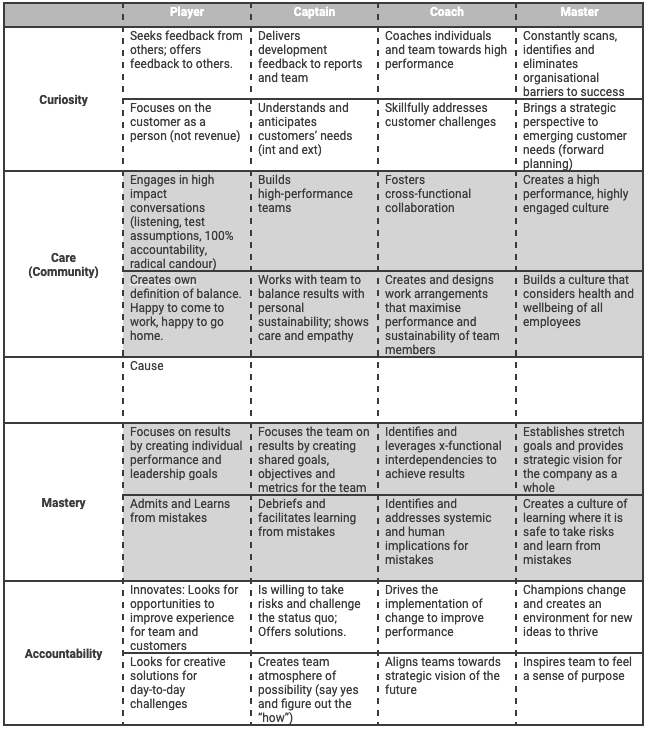Culture isn’t something that can be managed centrally. It’s an accumulation of what each manager and team does. It’s helpful to think of culture-building as bottom-up rather than top-down. And if you have a consistent culture, it’s because the managers in your organisation are behaving similarly.
So for any culture-building in your business to succeed, you need to have a blueprint. Otherwise, people will sense the mismatch and feel unfairly treated. It will also be impossible to go to market and hire people based on a set of values because there’s no clarity on what those values and behaviours are.
A big part of culture-building is accountability in the workplace. And the above holds true. You can’t just expect accountability to happen naturally. It needs deliberate focus and a structured, consistent approach. This is essential to building an accountable culture.
Lead by example through your actions.
Managers need to set themselves to a higher standard than their team. When coaching executives and agreeing on new behavioural charters, we advise them to run with these within the Executive team for the first six months. Only when they’re happy it works should they roll it out to the rest of the organisation.
They’re trying out a set of rules to which they can hold each other accountable. And these need to be realistic and achievable. If the leadership team don’t walk the walk, how can they expect anyone else to do the same? If they don’t invest this time up front, they risk breeding cynicism, and the effort to build accountability in the workplace will be doomed.
In the past, we’ve built leadership behavioural matrices which go through four levels based on the values of the business – player, captain, coach and master. Then there’s a framework to guide promotions, whether from sole contributor to manager, team leader to director or VP to C-level. People can see how their actions are measured against the framework for each stage. There are higher expectations the further up the ladder you climb. This way, managers can see what they need to do differently from their employees.
I include an example in my new book, ‘Mind Your F**king Business’.

Provide clear expectations about responsibilities and objectives.
There is a strong connection between expectation and employee engagement. We recently had Jim Harter, Chief Scientist of Gallup, on our Melting Pot podcast. The discussion centred on the significance of clear expectations for culture building and accountability. This is so vital that it’s the foundational, first question of the Gallup Q12 measure of staff engagement – ‘Do you know what’s expected of you at work?’ And to be in the top quartile of the companies Gallup measures, at least 75% of your staff should give this question the highest score.
If expectations are clear in your business, every team member will know at 5pm whether they’ve had a good or bad day at work. This is tangible to them. It’s why clear expectations are an accountability best practice. How can you be accountable when you’ve no idea what you’re responsible for? The best tools for setting these expectations are job scorecards and OKRs, and these should be rolled out for every member of staff.
Give constructive feedback and address poor performance.
Many businesses struggle with giving and receiving feedback. Yet it’s crucial to building an accountable culture. We suggest using tools such as ‘Stop, Start, Continue’, which will help your managers navigate their discomfort around tricky conversations about poor performance.
To make judgements about performance, there needs to be clarity on a day-to-day level. What are the leading indicators that you’ve identified for this job in this business? For example, in sales, it might be the number of proposals, emails or LinkedIn messages sent. These should be measured daily, and every employee should know the score. Only then can judgements be made about performance.
And when performance is poor, coaching interventions should be put in place. For example, we worked with a sales team a while ago and identified that to retain their post as a telephone-based salesperson, they needed to spend at least three hours a day on the phone. So the manager’s job was to coach the team, share individual data on cumulative minutes spent on the phone, and address the issue where people were failing to hit the number.
Align incentives and recognition with key results.
Talented people will find motivation in success, particularly if it leads to a meaningful purpose. Last week, I was working with a client whose purpose is to help entrepreneurs reach their full potential. They do this by taking away non-critical admin tasks. Their advertising campaign in the US is centred on entrepreneurs reading more bedtime stories. They can do this because, by using our client’s services, they’re not bogged down in the slog of admin. I could see how this could capture people’s imagination and fire them up.
This client doesn’t pay their sales team commission. They’re targeted on the number of new entrepreneurs they win monthly, and there is immediate recognition for any successes.
In ‘The Great Game of Business’, Jack Stack looks at ways to align incentives and recognition with key results. First, you have to decide what to measure. Maybe company profitability? After all, that’s the measure of competitive advantage. Stack’s approach is to bonus the whole organisation on profitability. And then pay this quarterly rather than annually. Annual bonuses are too far into the future. No one will change their behaviour for an incentive that’s a year out.
Stack recommends setting an annual target and dividing the bonus as follows: 10% in Quarter 1, 20% in Quarter 2, 30% in Quarter 3 and 40% in Quarter 4. I like this approach. Quarter 1 is probably in the bag due to work in the previous year, but the 10% payment is enough to keep people interested. Then it’s cumulative, so if you miss one quarter, you can catch up and get it in the following one. All of this builds accountability in the workplace. And it incentivises the whole company to work together to achieve the key results.
Building an accountable culture that lasts.
Often, I turn up in organisations where people tell me, ‘We don’t have a culture of accountability.’ Usually, it’s difficult for the CEO. They’re fantastic at creating and selling a vision but find it hard to be structured and deliberate around holding people to their promises.
But if you hire the right people, they should be self-motivated. I don’t think it’s the job of any leader to motivate their people. Get the right people on board and give them the means to hold themselves to account. Ensuring transparency around expectations, measuring pre-agreed outcomes, using constructive feedback mechanisms and having incentives aligned with key results will all help with this. Get this in place, and you’ll foster a long-lasting culture of accountability in your organisation.
Written by business coach and leadership coaching expert Dominic Monkhouse. You can order your free copy of his book, Mind Your F**king Business here.

